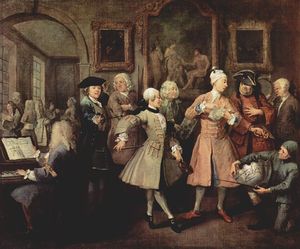Levée

The levée (from the French word lever, meaning "getting up" or "rising") has traditionally been a daily moment of intimacy and accessibility to a monarch or leader. It started out as a royal custom, but in America, it later came to refer to a reception by the King’s representatives and, even later, by the President.
History
France
In "Einhard's Life of Charlemagne" the author recounts the Emperor's practice, when he was dressing and putting on his shoes, to invite his friends to come in, and in case of a dispute brought to his attention, "he would order the disputants to be brought in there and then, hear the case as if he were sitting in tribunal and pronounce a judgement."
By the second half of the sixteenth century, it had become a formal event, requiring invitation. In 1563 Catherine de' Medici wrote in advice to her son, the King of France, to do as his father (Henry II) had done and uphold the practice of lever. Catherine describes that Henry II allowed his subjects, from nobles to household servants, to come in while he dressed. She states this pleased his subjects and improved their opinion of him.
This practice was raised to a ceremonial custom at the court of King Louis XIV. In the court etiquette that Louis formalized, the set of extremely elaborated conventions was divided into the grand lever, attended by the full court in the gallery outside the king's bedchamber, and the petit lever that transpired in degrees in the king's chamber, where only a very select group might serve the king as he rose and dressed. In fact the king had often risen early and put in some hours hunting before returning to bed for the start of the lever. Louis's grandson King Philip V of Spain and his queen typically spent all the morning in bed, as reported by Saint-Simon, to avoid the pestering by ministers and courtiers that began with the lever.
The king's retiring ceremony proceeded in reverse order and was known as the coucher.
The successors of Louis XIV were not as passionate about the Sun King's daily routine and over time the frequency of the lever and coucher decreased, much to the dismay of their courtiers.
Britain
When the court of Charles II of England adopted the custom, first noted as an English usage in 1672, it was called a levée. In the 18th century, as the fashionable dinner hour was incrementally moved later into the afternoon, the morning reception of the British monarch, attended only by gentlemen, was shifted forward towards noon.
The practice of holding court levées was continued by the British Monarchy until 1939. These took the form of a formal reception at St James's Palace at which officials, diplomats, and military officers of all three armed services, were presented individually to the sovereign. Full dress uniform or court dress was worn by all participants, who formed a queue in the Throne Room before stepping forward when their names and ranks were called. Each then bowed to the king who was seated on a dais with male members of his family, officials of the Royal Household and senior officers behind him. Similar ceremonies were held by the viceroy in India and the lord-lieutenant in Ireland, acting as royal representatives. Today the ceremonial events of the Canadian Governor General's New Year's Day reception is still called his levée.
United States
By the 1760s the custom was being copied by the King's representatives in British America, the colonial governors. Following American independence the levée became a social gathering, i.e., the presidential levée-established by President George Washington. Washington opened the presidential mansion weekly to the public, allowing Washington to greet and meet the public. The presidential levée was carried forward by John Adams and subsequently ended by Thomas Jefferson.
- More information is available at [ Wikipedia:Levée ]
Chat rooms • What links here • Copyright info • Contact information • Category:Root